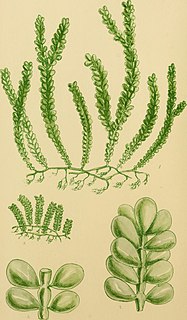
Caulerpa taxifolia is a species of seaweed, an alga of the genus Caulerpa native to the Pacific Ocean and Caribbean Sea. It is widely used ornamentally in aquariums, because it is considered attractive and neat in arrangement, and is easy to establish and care for. The alga has a stem (rhizome) just above the seafloor. From this stem grow vertical fern-like pinnae, whose blades are flat like those of the yew (Taxus), hence the species name taxifolia.

Caulerpa is a genus of seaweeds in the family Caulerpaceae. They are unusual because they consist of only one cell with many nuclei, making them among the biggest single cells in the world. A species in the Mediterranean can have a stolon more than 3 metres (9.8 ft) long, with up to 200 fronds. This species can be invasive from time to time.

Caulerpa racemosa is a species of edible green alga, a seaweed in the family Caulerpaceae. It is commonly known as sea grapes and is found in many areas of shallow sea around the world. There are a number of different forms and varieties, and one that appeared in the Mediterranean Sea in 1990, which is giving cause for concern as an invasive species.

Padina pavonica, commonly known as the peacock's tail, is a small brown alga found in the Indian Ocean, the Pacific Ocean, the Atlantic Ocean and the Mediterranean Sea. It inhabits pools in the littoral zone typically with clayey, silty or sandy sediments. Other habitats include rocks and shell fragments in the shallow sublittoral, seagrass meadows, mangrove roots and coral reefs on tidal flats

Limu, otherwise known as rimu or ʻimu is a general Polynesian term for edible plants living underwater, such as seaweed, or plants living near water, like algae. In Hawaii, there are approximately one hundred names for kinds of limu, sixty of which can be matched with scientific names. Hundreds of species or marine algae were once found in Hawaii. Many limu are edible, and used in the cuisine throughout most of Polynesia.

Halimeda tuna is a species of calcareous green seaweed in the order Bryopsidales. It is found on reefs in the Atlantic Ocean, the Indo-Pacific region and the Mediterranean Sea. Halimeda tuna is the type species of the genus Halimeda and the type locality is the Mediterranean Sea. The specific name "tuna" comes from the Taíno language, meaning "cactus" and referring to the resemblance of the thallus to the growth form of an Opuntia cactus.

Cymodocea nodosa is a species of seagrass in the family Cymodoceaceae and is sometimes known as little Neptune grass. As a seagrass, it is restricted to growing underwater and is found in shallow parts of the Mediterranean Sea and certain adjoining areas of the Atlantic Ocean.

Caulerpa prolifera is a species of green alga, a seaweed in the family Caulerpaceae. It is the type species of the genus Caulerpa, the type location being Alexandria, Egypt. It grows rapidly and forms a dense mass of vegetation on shallow sandy areas of the sea.
Stypopodium zonale is a species of thalloid brown alga in the family Dictyotaceae. It is found in shallow waters in the Caribbean Sea and in various other tropical and sub-tropical seas around the world.
Lobophora variegata is a species of small thalloid brown alga which grows intertidally or in shallow water in tropical and warm temperate seas. It has three basic forms, being sometimes ruffled, sometimes reclining and sometimes encrusting, and each form is typically found in a different habitat. This seaweed occurs worldwide. It is the type species of the genus Lobophora, the type locality being the Antilles in the West Indies.

Caulerpa brachypus is a species of seaweed in the Caulerpaceae family. It was first described in 1860 by the Irish botanist William Henry Harvey, having been collected during the North Pacific Exploring and Surveying Expedition of 1853 to 1856. Although native to the Indo-Pacific region, it has spread elsewhere and is regarded as an invasive species in the United States.

Caulerpa cupressoides, commonly known as cactus tree alga, is a species of seaweed in the Caulerpaceae family.

Caulerpa longifolia, commonly known as feather caulerpa or long-filament caulerpa, is a species of seaweed in the Caulerpaceae family.
Caulerpa scalpelliformis is a species of seaweed in the Caulerpaceae family.

Caulerpa sedoides, also known as mini-grapes or bubble caulerpa, is a species of seaweed in the Caulerpaceae family native to Australia.

Caulerpa sertularioides, also known as green feather algae, is a species of seaweed in the Caulerpaceae family found in warm water environments.

Caulerpa verticillata is a species of seaweed in the Caulerpaceae family.

Caulerpa webbiana, commonly known as bottlebrush green seaweed, is a species of seaweed in the family Caulerpaceae.

Caulerpa subserrata is a species of seaweed in the Caulerpaceae family.














